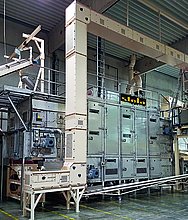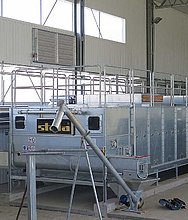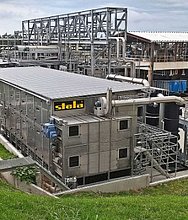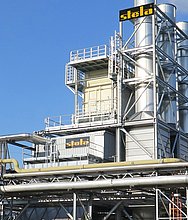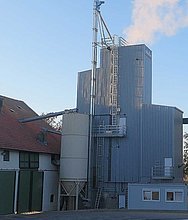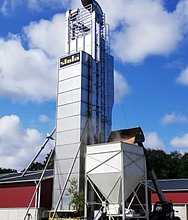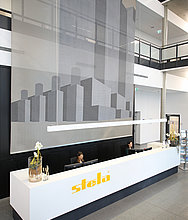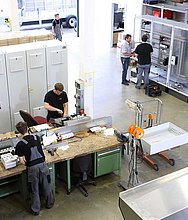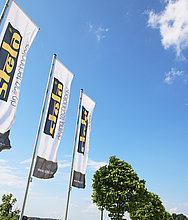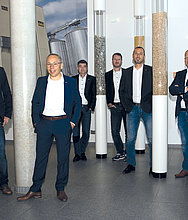Yves Marc Schade, Stela Laxhuber, discusses at World Cement Magazine the potential for operators to reduce their emissions using refuse-derived fuels and offers advice on the best techniques and machinery available to prepare these materials for efficient, sustainable combustion.
Refuse-derived fuel (RDF) is produced with municipal solid waste that has been processed to remove non-combustible materials. Belt dryers are commonly used in the RDF production process to dry the waste material before it is converted into fuel. Some of the advantages of low-temperature belt dryers for drying RDF are:
- Energy efficiency: Low-temperature belt dryers use significantly less energy compared to high-temperature dryers. This means that low-temperature dryers are more energy-efficient and can help reduce operating costs.
- Reduced emissions: Low-temperature belt dryers produce less emissions than high-temperature dryers, making them more environmentally friendly. This is because the low-temperature drying process produces less moisture and requires less fuel to operate, resulting in lower emissions.
- High quality product: Low-temperature belt dryers help maintain the quality of the RDF product by preventing it from overheating and breaking down. This results in a more consistent and high-quality product.
- Improved safety: Low-temperature belt dryers are safer to operate than high-temperature dryers, as there is less risk of fire and explosion. This is because the lower temperatures used in the drying process reduce the risk of ignition and combustion.
- Versatility: Low-temperature belt dryers can be used for a wide range of materials, including RDF, due to their gentle drying process. This means that the same equipment can be used for multiple applications, reducing the need for additional equipment and thus saving money.
Belt dryer advantages
Overall, low-temperature belt dryers offer several advantages over high-temperature dryers for drying RDF, including energy efficiency, reduced emissions, high-quality product, improved safety, and versatility.
RDF can be used in a carbon neutral cement production process by replacing fossil fuels, such as coal and natural gas, which are traditionally used as the primary energy source in cement manufacturing. Here are some ways RDF can be utilised to achieve CO2 neutrality in cement production:
- Alternative fuel: RDF can be used as an alternative fuel in the cement kiln, replacing a portion of the fossil fuels used to generate heat. This reduces the carbon footprint of the cement production process by reducing the amount of fossil fuels burned and the associated CO2 emissions.
- Energy recovery: The energy content of RDF will be elevated by using excess heat generated during clinker cooling. This reduces the need for fossil fuels and ensures that the energy content of the waste material is utilised in an efficient and sustainable manner.
Working with RDF
The use of RDF in cement production can reduce the carbon footprint of the cement manufacturing process and help achieve CO2 neutrality. By utilising RDF as an alternative fuel and recovering its energy content, the need for fossil fuels can be reduced, resulting in lower emissions. Additionally, by capturing and storing CO2 emissions, the cement production process can become carbon neutral or even carbon negative. The use of RDF is likely to have a significant impact on cement production in the future. As the world seeks to transition to more sustainable and low-carbon energy sources, RDF has emerged as a viable alternative fuel source for cement production. Here are some ways in which the usage of RDF is likely to impact cement production in the future:
- Reduced carbon footprint: The use of RDF in cement production can significantly reduce the carbon footprint of the cement manufacturing process. By replacing fossil fuels with RDF, the emissions associated with cement production can be greatly reduced, helping to mitigate the impact of the cement industry on the environment.
- Energy efficiency: RDF can help to improve the energy efficiency of cement production by providing a more efficient and sustainable source of fuel. This can help to reduce energy consumption, lower costs, and improve the overall sustainability of the cement production process.
- Waste management: The use of RDF in cement production can help to address the growing problem of waste management by providing a sustainable outlet for waste materials that might otherwise end up in landfills. This can help to reduce the amount of waste generated and minimise the environmental impact of waste disposal.
- Regulations and incentives: Governments around the world are increasingly implementing regulations and incentives to encourage the use of alternative fuels, including RDF, in cement production. This is likely to drive the adoption of RDF in the cement industry and further accelerate the transition to more sustainable forms of energy.
Summary
Overall, the use of RDF is likely to have a significant impact on cement production in the future, helping to improve the sustainability and efficiency of the cement manufacturing process while reducing the industry’s impact on the environment.
source and copyright: World Cement Magazine, August 2023











